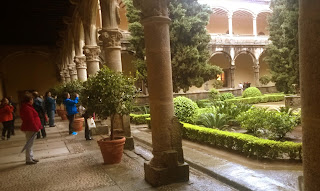I started writing this series of Posts
through conversations with my dad in presence and… That’s how I leave it. Dad,
I can’t consult you doubts anymore, may you rest in peace.
Thank you, I have struggled to get back to
writing.
My dad didn’t have any ambition in getting
out of the village whatsoever. He was close to his parents, he liked hunting
(by hand), dominoes and his job. My dad was a doctor.
During the 50s (in the XX century) to be a
doctor, with such a respected contract (medical) in a humble village of La Vera
region… lived with… certain comfort, being at the same time very highly
regarded and respected. (The agents of the authority will assist the Holders of
this card, keeping in all cases the due considerations), was written at the
bottom of the card of the Official College of Doctors.
The first place my dad went to as a doctor
was Yanguas de Soria, and the second Aldeanueva de la Vera (towns
in areas of Spain).
In Aldeanueva, he looked for a house
downtown, of which we occupied the last floor. It didn’t have “running water”.
Every morning, we would bring up pitchers of water for cooking and personal
hygiene. During that period, there were people whose job consisted of doing
those tasks and there were professions such as the aguador (water
carrier), that were very popular at the time.
In front of our house there was a plot that
ended in the road, a road that we would call today camino(dirt road)
given that it was made of soil. That kind of roads required the job of the now
forgotten peones camineros (road workers).
That was one of the biggest issues of the
region up until the 70s, communications. The roads, or trails rather, always
full of rough paths and not very well taken care of, made the trips slow and
uncomfortable. This was the main reason why the isolation of the area and
progress took so long in coming.
Dad would wake up early on Sundays. He
would wear corduroy pants, a wool sweater, a pair of mountain boots and a hat.
Dad always protected his head with a hat. Before leaving the house, he would
adjust his worn leather cartridge belt to the hips, checking that he had half a
dozen of type 12 cartridges. The night before, he had prepared and loaded up
all the cartridges with the press he had inherited from his dad, who lived in the
nearby village of Losar de la Vera.
Hunting was quite a craft at the time. It
required preparation and knowledge on different matters. It was a blend of
professions rather than a hobby.
Once he was ready, he would take his
leather pouch, as a bandolier, and checked that he had his wine boot, some
bread and meat inside. The only thing left for him to do was to pass by
Bartolomé’s farmyard, where he kept Day, his hunting dog.
Day looked like a pointer, but my dad could
never quite figure out what his real breed was. A friend from university in
Salamanca (I believe my dad told me his name was Julián, also a doctor), left
him for my dad to take care of him when Julián was sent to work in Valladolid.
Dad received him 4 years before I was born and died when I was 10. Day had just
turned 14 when he stopped running after the balls, we would throw at the road
for him to take.
Dad actually preferred to go hunting. He
wasn’t really bothered if someone went with him every now and then, but he
would always tell me: “Carlitos, hunting requires focus and silence. Day and I
are enough. We don’t go to the stubbles the same way we would to a romeria…”.
He mentioned “stubbles” in a generic way, but he would usually go more around
the hollows and small cliffs, the stubbles were way further away from the
village.
Dad always hunted a la mano (by hand) as he
used to say; al salto (oppressive hunting), as it is said in a more
academic way.
He would walk out of the village, go down
the trail that bordered the gorge of los Guachos (place name) and
usually arrive even further from the junction with the gorge of San Gregorio
(place name). Dad always loved walking. I would always tell him that he liked
walking more than hunting, to which he replied: “you’re such a joker”, smiling,
but never denying what I had said. I never saw him angry for not having caught
a prized catch.
There were so many days he would come back home empty-handed, others, however, with a partridge or a rabbit. The feast was when he hunted a hare.
Dad gave a special value to hunting a hare. The thing, though, is that he liked better eating rice with rabbit, but he thought it had much more merit to hunt a hare. Dad was very happy outdoors, in the open, walking and “shooting at something, when the opportunity arises…”, as he used to say.
Dad gave a special value to hunting a hare. The thing, though, is that he liked better eating rice with rabbit, but he thought it had much more merit to hunt a hare. Dad was very happy outdoors, in the open, walking and “shooting at something, when the opportunity arises…”, as he used to say.
What really filled him with happiness, was
to be in contact with nature.
Carlos, son of Teófilo
-----------------------
Active Tourism, an eco-awar family enterprise from Extremadura: Conyegar
Carlos, son of Teófilo
-----------------------
Active Tourism, an eco-awar family enterprise from Extremadura: Conyegar










